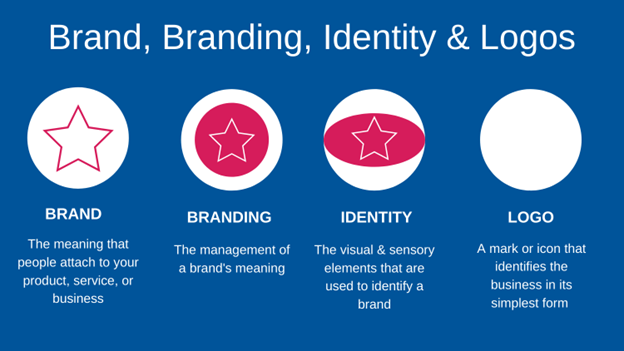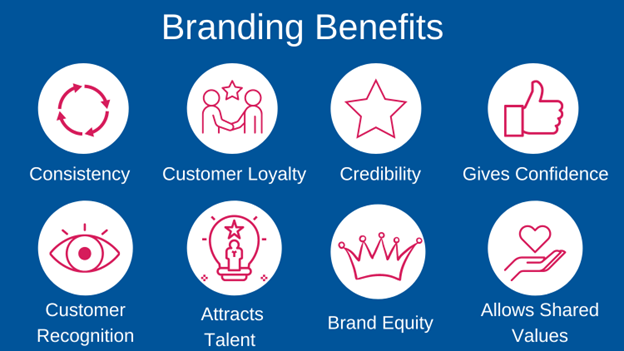Business branding vs. brand identity. They're not one and the same.
Both branding and brand identity work to enhance your business, but how?
Let's turn to Seth Godin for help: "A brand is a set of expectations, memories, stories, and relationships that, taken together, account for a consumer's decision to choose one product or service over another."
So if your branding is the basis of your brand, what is your brand identity?
Those questions and more are answered in this article. We'll uncover five key differences between branding and brand identity, and we'll look at both in more detail.
Brand, Branding, and Identity in a Nutshell
"The way a company brands itself is everything.... It will ultimately decide whether a business survives." —Sir Richard Branson:
Here are a few useful definitions:
- Brand. The meaning people attach to your organization, product, or service. It's who you are as a business—and, more specifically, who your audience perceives you to be.
- Branding. The perception of a brand is shaped by branding—the management of a brand. Branding is the deployment of the strategic plan for your brand so that you ensure your audience perceives your business as you intend.
- Identity. The sensory elements used to identify a brand, including your logo, colors, website, brand photography, and digital marketing efforts.

With that essential information in mind, let's explore five key differences between branding and brand identity.
1. Your brand identity is tangible
While your business's brand is abstract, your brand identity is material. Brand identity takes the form of physical (also digital) goods, such as stationery, brochures, books, signage, apparel, and anything else that can be marked with your brand's logo. Your brand identity efforts are what your audience associates with your brand.
2. Branding is an action
Sending out an email campaign, posting on your business's social media channels, and creating new website content are all actions that work toward forming your company's branding.
Branding is communicating to your audience what your business is about, why it exists, and why it's better than the competition.
For instance, a career coaching business can be branded as professional and exclusive, a children's toy as fun and educational. or a camera as an outdoor and sports equipment.
3. Your brand is (in part) your tone of voice
How you communicate with your customers comes under your brand. For instance, if you consider your business to be a responsive brand, all of your messaging should mirror that. Your tone of voice reflects how quickly your business adapts to current market trends and pivots its products and services accordingly.
4. Branding is an action verb
Your business's brand takes care of the "who" of your company. Branding acts as a verb and describes the "how" part of the brand puzzle.
To ensure your marketing efforts are consistent when you're considering business branding, ask yourself:
- How will your business deliver its key message?
- How will your mission statement be displayed?
Elements of your business, such as live virtual receptionist services, make up part of the branding experience. Exceptional customer service via this method reinforces your business's positive communications strategy, for example.
Branding, at its core, is a marketing function. Branding marketing campaigns create brand awareness and encourage your target audience to buy from you because great branding is what keeps people coming back as repeat customers.
5. Design is the basis of brand identity
Establishing a consistent brand identity means your customers have no problem recognizing your brand.
Your business logo is just one element of your brand identity, but, together with other visual brand elements, it works to provide your customers with the reassurance they need that they're in the right place.
Why Is Branding Important?

- It improves recognition. Your brand is more recognizable when branding efforts are consistent across communication channels.
- It creates loyal customers. By adhering to your brand promises, you naturally create advocates for your business.
- It differentiates your business. Communicating your business's values in a consistent manner makes you stand out from the competition.
An Example of Brand Identity
Arguably one of the most recognized brands in the world, Google is an example of an incredibly successful brand identity. Its friendly bright color palette is synonymous with its brand and is incorporated throughout the business's message.
Google uses its brand identity to give its customers confidence that they can expect the same experience regardless of which Google service you use.
Building Your Brand Identity
Growing a successful brand identity comprises the following elements:
- Logo: Your business logo is the symbol of your brand. It should be instantly recognizable.
- Website: A compelling business website creates an image of professionalism.
- Business name: Your business name is a big part of your brand identity. How catchy it is and how different and memorable from other companies is a good measure of its success.
- Colors and fonts: It's essential to create a color palette to use across business communications. Different colors and fonts evoke different responses from customers, and your ultimate choice will determine how your business is perceived.
- Brand voice: Match your brand voice to your business products, services, and ethos. Your brand voice must be reflected through all digital communications, including social media, as well as physical collateral, such as brochures.
A brand style guide is a great idea to keep all your brand identity elements in one place for team members to refer to. A guide helps ensure everyone concerned has an apt understanding of your business and the message it's conveying, and it helps deliver consistency and therefore reassurance to all audiences.
How to Nail Your Branding
The most effective branding strategy depends on your business model and target audience. Take the time to delve deep into your customer personas, find out where your target audience resides, and then create branding strategies to deliver your message in the right places.
For example, promoting your enterprise VoIP phone system would perhaps not be effective on some social media channels, but targeted business email campaigns and consistent website content would be ideal.
* * *
"Every interaction, in any form, is branding," according to Seth Godin.
To recap…
- Brand: What your audience thinks and feels about your business and products or services.
- Branding: The process of growing and nurturing your brand.
- Brand identity: Tangible entities that can be seen, heard, touched, or held.
It's impossible to have a strong brand identity without a brand. Likewise, you can't have a successful brand without a brand identity.
To build a lucrative business, your branding and brand identity must work in harmony to create marketing campaigns that sell to new customers, win back lost customers, and drive business growth.
More Resources on Branding vs Brand Identity
Build Your Brand on a Solid Sense of Your Identity
Brand Dracula: Four Branding Lessons From the Undead
Rebranding: Five Steps to Building a Story of Evolution and Growth




